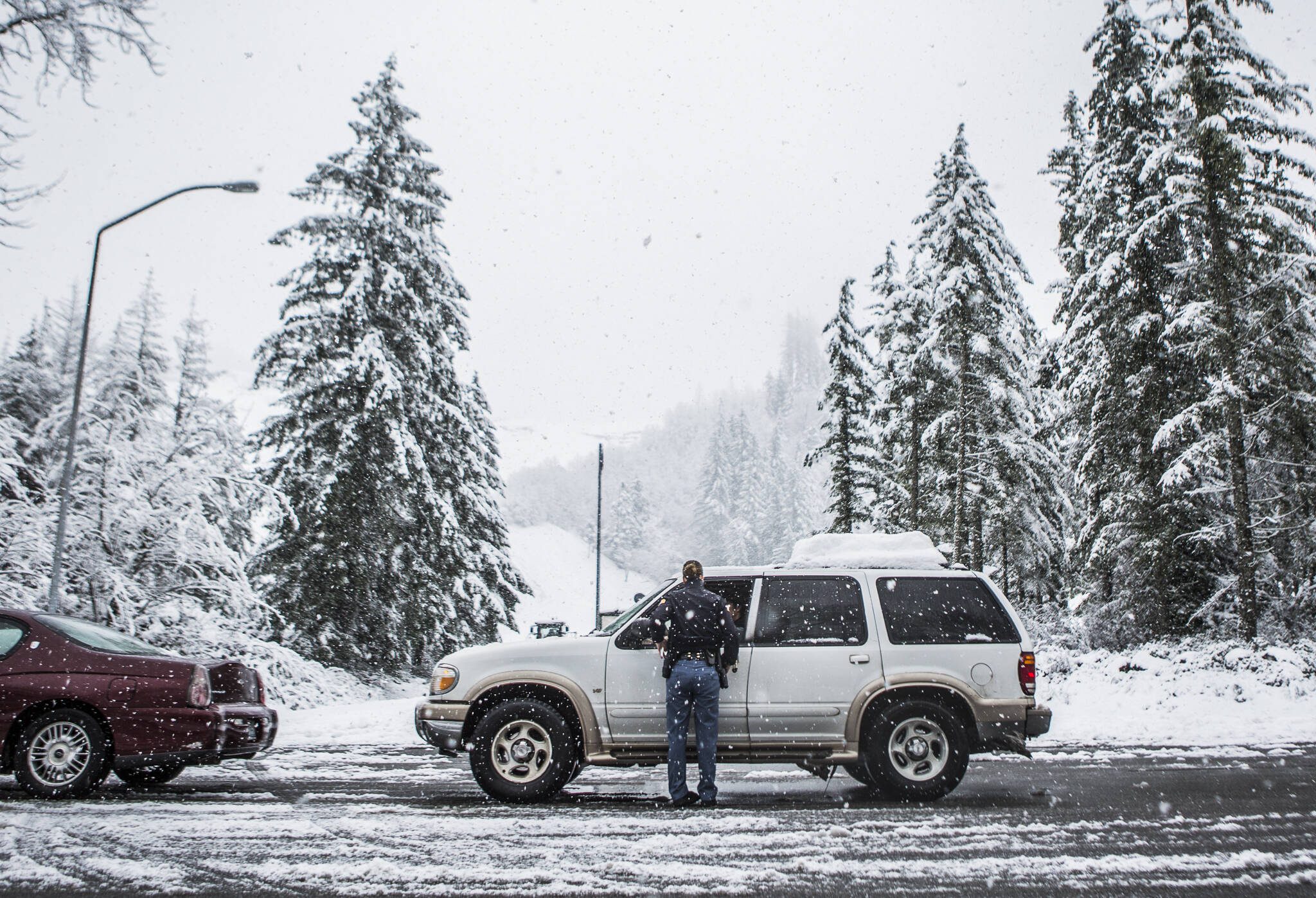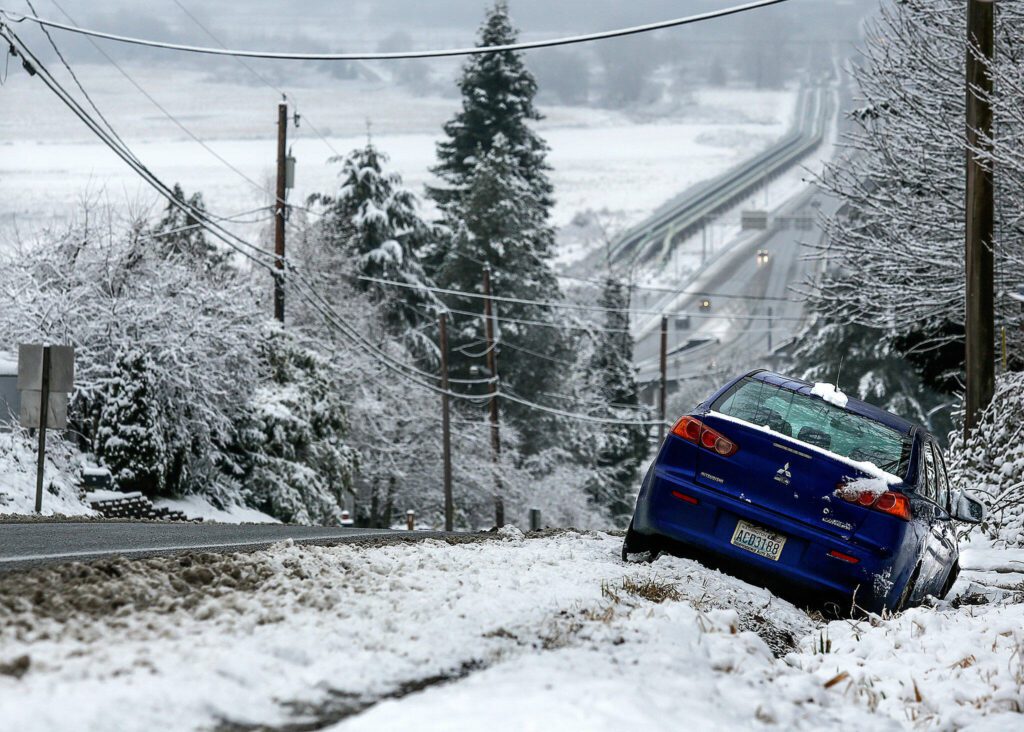EVERETT — There is a winter driving story I like to tell so much that some closest to me may have gotten a little tired of hearing. But with freezing weather in the forecast for the lowlands, and snow hitting Washington’s passes, it seems like a good time to repeat it.
It begins in Alberton, Montana, a town along I-90 where I’d just wrapped up covering a wrestling meet. It was about 5 p.m. and I needed to get to make the 29-mile trek back home to Missoula. This stretch of I-90 following the Clark Fork River is narrow.
Because of the geography — the river runs through a shallow canyon most of the way — snow can fall extremely quick. It’s known as a “snowburst.” And on this drive, I was caught in one, in whiteout conditions, trying to find a road covered in inches of snow.
Hindsight says I should have stayed the night in Alberton, or at least waited until the road was clear. But it looked clear driving out of the small town.
Three miles down the road, a wall of snow greeted me. It would last until I saw the lights of Missoula. It was dangerous, scary driving. I was wearing a T-shirt underneath a flannel long-sleeve. And by the time I pulled into The Missoulian’s parking lot, I had fully sweated through the shirt.
Most of the drive I thought there was a good chance I’d die, or at the very least, end up in the ditch. And in a ditch, along a road deep in the Rocky Mountains, is a scary place to be. By the grace of the powers above, I made it. About 5 miles outside of Missoula, I finally found a snowplow to get behind until I got to my exit.
It was lightly snowing in Missoula, a far cry from the howling snowstorm along the way. It is probably my most intense memory from my five years in Montana.
What I took from my time driving in winter in Montana — and, to a lesser extent, when I was in Iowa — is the importance of being prepared for what winter can throw at you. I also learned that sometimes you just need to get off the road, because trying to push can get you killed.
The first thing to know about driving in winter weather?
Don’t — if you can help it.
Washington’s passes can be dangerous. Stevens Pass gets up to over 4,000 feet of elevation. Ice, snow and elevation change is a potent combination. Snoqualmie Pass is so dangerous that the Seattle-based Davis Law Group has an entire webpage dedicated to crashes on the pass.
Since November, there have been 31 crashes on the west side of Stevens Pass, Washington State Patrol spokesperson Kelsey Harding said.
Forecasts indicate Cascade passes could get 9 to 15 inches of snow over the weekend.
“If you’re not comfortable driving in the snow or you know it’s going to be a huge backup, sometimes it’s worth it to just stay home,” Harding said. “Driving in the snow can be scary. I get it, we do it.”
Always check the state’s mountain pass map at wsdot.com/travel/real-time/mountainpasses/ before getting in the car. An interactive map allows users to get a “pass report” on local conditions and weather. It is the first thing the state Department of Transportation recommends looking at.
“It’s always good to check before you leave,” said Meagan Lott, a department spokesperson. “But then again, have a passenger check our app with the same information as conditions can change.”
The second thing is to keep winter weather gear in your vehicle. I use a hard-sided tote with the basics — my dad’s trusty jumper cables, tire patch kit, wrenches and screwdrivers, tire iron and even some rope. I also have chains for my car tires. Those get moved to the backseat if I’m going to be driving in snow.
I have all-weather tires and have never felt the need for snow or studded tires. Studded tires are only legal from Nov. 1 to March 31 in Washington. Use of studded tires before or after those dates can result in a $137 fine. Even with studded tires, cars are still required to use chains.
Chains are important and often required at higher elevations in winter, whether the weather is rough or not.
Harding said police can and will enforce chain violations, including after a crash. Putting chains on for the first time in ice and snow on the side of the road is not recommended.
“The best advice for drivers is to practice putting on chains before they get into inclement weather,” Lott said. “It’s easier to kind of make mistakes and learn how to put them on when you’re not in freezing conditions, it’s snowing, or there’s slush.”
Lott added it is important to know which tires the chains go on as well.
I keep other emergency items in my car year-round including a heavy winter jacket, which for me is a 12-year old insulated Carhartt.
Other items in my day bag or trunk include:
• First-aid kit: I build by own, but most stores carry a basic one;
• Firestarters, both matches and flint;
• Gloves: I carry work gloves and running gloves, but mittens are a good choice;
• Paracord;
• Rechargeable battery, to plug my phone into;
• Change of clothes;
• A small shovel;
• Cat litter or sand, for traction if stuck.
The things I realized I was missing? Flares and some of those triangular emergency warning signs.
I also need to grab some new handwarmers and non-perishable food and water in there, as well. I usually carry a water bottle, but some sealed water in the trunk seems like a good idea.
Never drive in a snowplow driver’s blindspot and give them plenty of space to work.
Lastly? Slow down.
“Slowing down and driving safe is so much better because you get there, versus making it dangerous for yourself and others when you rush and go above the limit you should go,” Harding said. “Yes, it might be posted at 60, but driving conditions, road conditions, weather conditions can make it where the safe driving speed is 45 or 50, especially in corners.”
Harding has one final piece of advice, too: “Seatbelts, seatbelts, seatbelts.”
I was lucky on my snowy, terrifying drive years ago.
I have no interest in testing that again.
Jordan Hansen: 425-339-3046; jordan.hansen@heraldnet.com; Twitter: @jordyhansen.
Talk to us
> Give us your news tips.
> Send us a letter to the editor.
> More Herald contact information.


























